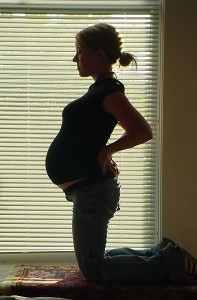Booby Traps Series: VBAC is a breastfeeding issue. Lack of access to VBAC is a Booby Trap for millions of moms.
by Tanya Lieberman, IBCLC | May 28, 2013 6:15 am
 The Listening to Mothers III survey, published by Childbirth Connection this month, contained a set of sobering statistics.
The Listening to Mothers III survey, published by Childbirth Connection this month, contained a set of sobering statistics.
This survey found that, while moms’ interest in VBAC is increasing (from 45% to 48%), “the proportion of women with a prior cesarean who reported a lack of access to VBAC grew to 56% in the current survey from 42% a decade earlier.”
How is that related to breastfeeding? It’s a big old Booby Trap. I’ll explain.
Between 1996 and 2007, VBAC births fell from 28.3% to 8.7%. And that’s a key reason why, according to the CDC, the cesarean birth rate in the U.S. hovers near an all-time high, at 33% in 2010. This despite the fact, according to the National Institutes of Health, the success rate of VBAC has remained constant at about 74%.
An estimated half of all U.S. hospitals do not permit women to attempt a VBAC. How do we know? The International Cesarean Awareness Network (ICAN) conducted a grassroots data collection effort, in which each delivery hospital in the country was contacted by ICAN members. They found that 30% of hospitals had an outright VBAC ban. Another 20% had a “de facto ban” - these hospitals didn’t have a formal prohibition, but there was no provider at the hospital would would attend a VBAC. And of the remaining 50%, they estimated that only 10% of the surveyed hospitals were actually VBAC supportive.
So how is lack of access to VBAC a Booby Trap?
(But before we get into this discussion, I want to say that having a cesarean birth certainly doesn’t doom your chances of breastfeeding. Many, many mothers, including myself, have breastfed without incident after a cesarean birth. But when we evaluate policies and practices that impact breastfeeding, we need to broaden our view beyond personal experience and examine the research on large groups of women. That’s what I’m doing in this post.)
It’s been clear for some time that cesarean birth poses challenges when it comes to breastfeeding. Linda Smith, in The Impact of Birthing Practices on Breastfeeding compiled research showing an association between cesarean birth and many breastfeeding issues, including:
- Significant delays in initiating the first feeding
- Increased risk of separation from mother following birth, and increased risk of baby being admitted to the NICU
- Delayed onset of mature milk supplies (“milk coming in”)
- For babies: altered sucking patterns, decreased neurological responses in the first two days, increased risk of respiratory problems in babies born by cesarean without labor, respiratory distress, low blood sugar, higher risk of infection in babies born by cesarean before 39 weeks gestation
- For mothers: a longer and more painful recovery, lower oxytocin and prolactin levels in the early postpartum period, increased risk of rehospitalization and infection, higher rates of anxiety and stress, higher risk of exposure to medications of concern
And possibly as a consequence, research has found that mothers who have had cesarean births:
- Are more likely to have stopped breastfeeding within the first two weeks postpartum
- Are more likely to not be breastfeeding at 2 months
Having a cesarean without labor, as in the case of scheduled CBACs, is independently associated with breastfeeding problems, such as lower rates of initiation, greater newborn weight loss, and reduced fetal endorphins and less endorphins (which act as pain killers) in breastmilk. Research has also found that babies born by cesarean without labor are more likely to be delivered early - a risk factor in itself for a number of breastfeeding related problems.
A new study comparing breastfeeding outcomes of VBAC, planned CBAC, and trial of labor ending in cesarean (TOL/CBAC), offers an illustration of this effect on a large sample of women:
Women delivered by successful VBAC were 47% more likely to initiate breastfeeding than women delivered by scheduled repeat cesarean. Women who ultimately delivered by cesarean section with unsuccessful trial of labor were also more likely to breastfeed than women with a scheduled repeat cesarean section (61% vs. 58.7%, respectively). [Breastfeeding rates : VBAC 66.6%; TOL/CBAC 61.3%; scheduled CBAC 58.9%]
It’s certainly possible that women who want to have a VBAC are also more likely to want to breastfeed, and this study did not collect information on prenatal breastfeeding intentions (one author tells me that such a survey is planned). But looking at the cesarean-after-trial-of-labor number compared to the scheduled cesarean number is where it gets interesting.
If this were all about intention to breastfeed, and mothers trying for a VBAC were more likely to intend to breastfeed, wouldn’t you expect to see rates for the TOL/CBAC mothers clustered together with the VBAC mothers, since they headed into labor with the same intentions? Instead, they’re clustered with the planned CBAC mothers. To me, this suggests that something else - perhaps the associations noted - is at play.
The American Pregnancy Association estimates that 90% of women with prior cesareans are candidates for VBAC. And the NIH estimates that 74% of the women who attempt a VBAC will end up delivering vaginally.
But that is simply not the case for millions of mothers each year. And that’s the Booby Trap - that lack of access to VBAC is causing mothers to struggle unnecessarily with breastfeeding.
Did you have a trial of labor after cesarean, VBAC, or CBAC? Were you unable to find a provider who would attend a VBAC? Did your birth experience affect your breastfeeding experience?
Source URL: http://www.bestforbabes.org/booby-traps-series-vbac-is-a-breastfeeding-issue-lack-of-access-to-vbac-is-a-booby-trap-for-millions-of-moms